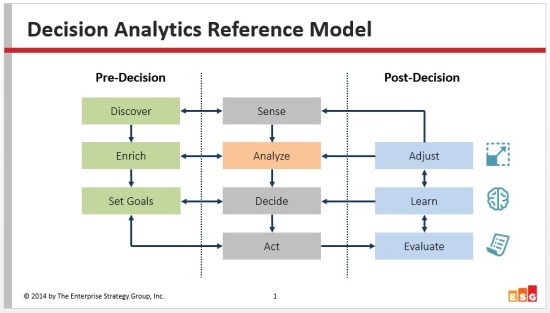
Most real-time decisioning falls under the category of sense and respond processing. Here, RTInsights expert contributor Stephen Hendrick defines a development reference model for decision analytics that can support this most demanding use case.
In a previous article on RTInsights entitled “Real-Time Application Development and Deployment,” I talked about human and machine interaction patterns. The Machine to Human (M2H) and Machine to Machine (M2M) patterns stood out as being patterns that will define the future of IT. This is because these patterns rely on sensor data, events and state changes to initiate analytics and decisioning that will drive business processes.
Because sensor data, events and state changes are inherently transitory, use cases will focus on addressing opportunities or concerns and driving value in real-time. In order to better understand what value is being driven in real-time, let’s look at the key constructs that are driving this value proposition.
Most real-time decisioning falls under the category of sense and respond processing. We live in a data-driven world. Data and events provide a wealth of information and opportunities for us to evaluate, make decisions and take actions. Actions or behaviors are what define and differentiate an enterprise. Because actions can be directly tied to utility, it is easy to dismiss the importance of the decisioning. However, no action should ever be taken unless preceded by a decision.
Decisioning is where context, alternatives, potential utility, objectives, constraints and trade-offs are evaluated and a next-based action is determined. Therefore, support for comprehensive decisioning is critical because the decision is where the choice is made between competing actions. This choice can have lasting impact, especially if it is strategic. This also means that decisions can have significant consequences, both positive and negative. Consequently, organizations will want to always make the best possible decisions that they can in order to maximize benefit and minimize risk over some time horizon.
Complex decision making needs real-time analytics
As decisions increase in complexity so, too, does the need for analytics to support the decision-making process. The point is, the decision model can be extended to include an analysis activity where the heavy lifting of evaluating alternatives is performed prior to decisioning. Separating analytics from decisions has distinct advantages. The primary advantage is a separation of concerns. The analyze activity is focused on understanding, quantifying and normalizing alternatives so that a rational and informed decision can be made.
Figure 1 below provides a decision analytics reference model. The primary flow through this model is down the center of Figure 1, encompassing Sense, Analyze, Decide and Act.
This model also includes pre- and post-decision flows. Pre-decision activities are a first step in bringing a life cycle to decision analytics. Pre-decision activities have strong bidirectional relationships with analytic decisioning because of their focus on decision improvement and the support they can provide prior to decisioning.
A separate set of post-decision activities complete the feedback loop. The post-decision activities consist of Evaluate, Learn and Adjust. The intent of the evaluate activity is to assess the utility generated by an act activity and compare it with the desired utility as defined by the set goals activity. The learn activity is the capability to remember the output of the evaluate activity. The evaluate activity also factors what has been learned into its assessments so that the utility of the current action can also be compared with past actions.
The role of the adjust activity is to consider the goals, decisions, actions and what has been learned to improve performance by changing the triggers, events, analysis and decisions. The adjust activity enables a closed loop system. The adjust activity is also one of the most complex activities that exists in this system. This is because changing policy and decisions changes actions, which will have a different impact than that to which the organization is accustomed.
Changes to policy that correct errors are expected to increase utility. However, changes to policy in search of added revenue are more challenging and must be evaluated more carefully to ensure that the return outweighs the risk. Economic models are very effective at evaluating risk and return, and can be incorporated into either the Adjust or Analyze activities.
This Decision Analytics Reference Model’s Significance
The significance of this decision analytics reference model is that it is supported by the most demanding use cases (i.e., Sense and Respond) but is equally adept for scheduled or batch activities. The Analyze and Decide activities in the model provide a very important level of indirection that decouples Sense from Respond. This provides immense navigational flexibility because application behavior can be dynamically adjusted. The granular design also ensures that actions are nonblocking so that all of the actions that can process in parallel do and that the number of sequential actions is minimized.
This may not sound like it is all that important given existing use cases but increasing data volumes, the requirement to leverage data streams (i.e., sensor data), and identify and address opportunities in real-time completely changes the way we must think about application behavior and, hence, about application development. Doing so enables us to think more creatively and extensively about how to support a wider variety of systems of engagement and generate new revenue streams all the while providing a much higher level of relevance to the customer.






























